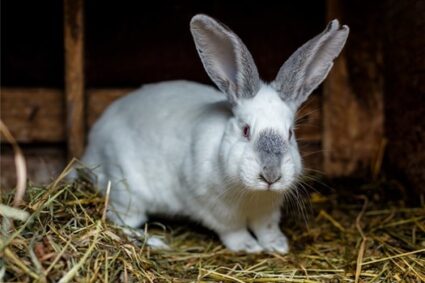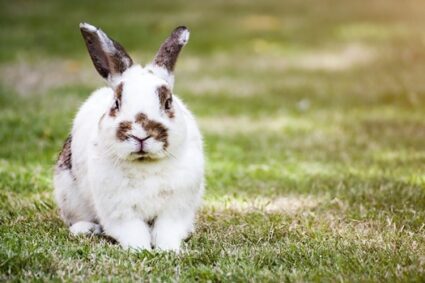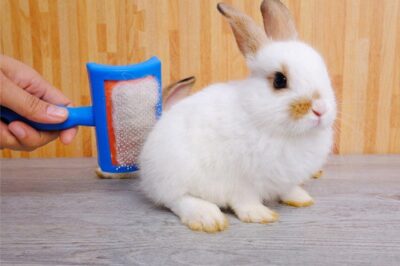While grooming, rabbits can inadvertently ingest their own fur. Normally, rabbits expel this hair in their feces. But sometimes, it can build up in the digestive tract and get stuck, forming hairballs. Hairball in rabbits is also known as wool block.
Small hairballs can often be shifted by adding more fiber to your rabbit’s diet. Feed them unlimited first cut Timothy hay, plenty of water, and fibrous snacks such as raspberry twigs. Pineapple juice can also help. But if the hairball is large, your rabbit may need veterinary intervention, including surgery.
We’re going to explore what hairballs are, and the causes of hairballs in rabbits. We’ll explain how to recognize the symptoms of wool block, and how to treat it. You’ll also find out how to prevent hairballs from forming in the first place.
What Are Hairballs in Rabbits (Trichobezoars)?
Hairballs are clumps of hair that can form in the stomach of an animal. Along with hair, they can also contain bits of undigested or partially digested food.
Hairballs are sometimes called “furballs,” or the scientific term “trichobezoars.” They commonly occur in furry animals that groom (lick) themselves, like rabbits.
During a grooming session, loose hairs can become accidentally ingested. Sometimes, hair that has fallen out into food or water bowls can also be swallowed.
Small amounts of loose hair usually pass through the digestive system with ease. But in some cases, hair can clump together into a ball, and get stuck. Depending on the animal, the hairball must then be coughed up (vomited), or expelled as feces.
In rabbits, hairballs can form that are too large to pass naturally. They can block the digestive system, causing rabbits to stop eating and drinking. This is called wool block, and is a medical emergency.
Longhaired rabbits, such as angoras, lionheads, and American fuzzy lops are particularly prone to wool block. They don’t groom themselves more often than other rabbits, but their hair is longer.
Usually, hairballs form because of a problem with the rabbit’s diet or care. But some rabbits can be more prone to hairballs than others, regardless of breed.
Do Rabbits Cough Up Hairballs?
Hairballs can be dangerous for rabbits because, unlike other animals, rabbits cannot vomit. So, rabbits can’t “cough up” hairballs when they form in the stomach. There’s nowhere for a hairball to go except through the digestive system, and out the other end.
If your rabbit has a healthy gut, small hair clumps should pass through by themselves. Provided the digestive system is healthy and continuously moving, hair should move through without forming hairballs.
But larger hairballs can cause a whole host of problems. For example, Laboratory Animal Science reported a case of acute peritonitis (infection of the intestinal lining) caused by a hairball. Your rabbit could even die if the problem is not addressed.
Causes of Hairballs in Rabbits
Rabbits are susceptible to hairballs because they love to groom themselves. But in rabbits that are well cared for, with healthy digestive systems, hairballs should not form.
All hairballs in rabbits are caused by too much hair ending up in the rabbit’s stomach. If there’s too much hair, it clumps together and becomes too large to pass through. The following factors could be responsible for too much hair in the stomach:
- Obsessive grooming (barbering). This is usually caused by boredom or stress. Rabbits that don’t get enough exercise or chew toys are particularly at risk.
- Insufficient brushing. You should brush your rabbit regularly to remove any loose fur. This is especially crucial when your rabbit is going through a seasonal molt.
- Inadequate dietary fiber. Fiber is essential as it helps push food through the digestive system. If your rabbit isn’t eating enough fiber, hair won’t be digested fast enough, and could clump together.
- Lack of water. Water is just as important as fiber. It helps soften and break down matter in the stomach and intestines.
- Illness. Many rabbit illnesses can cause a phenomenon known as gastrointestinal (GI) stasis. This is where the digestive system slows or shuts down. When this happens, hair can accumulate, forming hairballs.
GI stasis is an emergency in and of itself. If your rabbit isn’t eating, drinking or going to the bathroom, head straight to a veterinarian.

Symptoms of Hairball in Rabbits
Rabbits are excellent at hiding when something’s wrong, as appearing weak would make them vulnerable to predators. The problem with diagnosing wool block in rabbits is that the symptoms can easily be mistaken for other things. Symptoms of wool block in rabbits can include:
- Loss of appetite. If hair is blocking your rabbit’s GI tract, she’ll be less hungry. A large hairball may stop them from eating altogether. They may also lose weight as a result.
- Changes in poop. Your rabbit may excrete fewer droppings, or they may be smaller than usual. In severe cases, your rabbit may become constipated.
- Behavioral changes. Your rabbit may start acting differently to usual. They may seem depressed or cranky. They may stop running around, playing with toys, or asking to be pet.
- Pain. It’s difficult to tell when a rabbit is in pain, but watch for teeth grinding, or sitting hunched over.
- Lethargy. If the problem is severe, your rabbit may become reluctant to move.
All of these symptoms are indicative of general digestive problems, not just wool block. A great many different issues could be responsible.
So if your rabbit is demonstrating the above symptoms, they may have a completely different problem than hairballs.
To be sure, you should take your rabbit to a veterinarian for a diagnosis. Most hairballs must be treated by a veterinarian, as they may not pass on their own.
Is Hair in Rabbit Poop Sign of Hairballs?
Rabbits often ingest small amounts of hair while grooming. The hair gets passed through the anus along with poop. It’s normal to see bits of hair in your rabbit’s droppings every now and then.
Hair in rabbit poop is not a sign of hairballs in and of itself. If the hair is coming out, that means it’s not blocking the digestive system. If your rabbit seems healthy, and is eating and drinking normally, it isn’t a concern.
But if there is an excessive amount of hair in the poop, this suggests that too much hair is being ingested. This can increase the risk of a large hairball forming.
If your rabbit’s droppings often come out ‘strung’ together with hair, address the problem before it gets worse.
How To Treat Hairballs in Rabbits
If you suspect that your rabbit has hairballs, the first step is to take it to a veterinarian. A rabbit-savvy vet will be able to tell whether your bunny has a hairball, and how severe the problem is.
The veterinarian will examine your rabbit’s stomach. They will feel around to see if they can detect a mass that shouldn’t be there. They’ll also give your rabbit a general-check up and ask questions about symptoms you’ve noticed.
Once wool block has been diagnosed, your veterinarian will recommend treatment. Which treatments they use will depend on how big the hairball is, and your rabbit’s general health. Treatments may include:
- Abdominal massage. Sometimes, careful massaging of the stomach can help move the obstruction along. Never attempt to do this yourself, as you may hurt your rabbit.
- IV fluids. Your vet may recommend administering fluids to help rehydrate your rabbit’s digestive system. They may also feed your rabbit a special high-fiber mixture.
- Pain relief. Hairballs cause a lot of pain. This can make your rabbit avoid food and drink, which can worsen the problem. Analgesics may be given to help your rabbit feel better.
- Digestive stimulants. Medication may be administered to encourage the gastrointestinal tract to start moving. This can help your rabbit pass the hairball.
- Enzyme tablets. These contain enzymes that help break down hairballs.
- Hairball removal surgery. If the hairball is too large to respond to other treatments, surgery may be necessary to remove it.
If the hairballs are small enough, your veterinarian may advise that you can treat the issue at home. Surgery is only considered as an ultimate last resort.
Can Rabbits Die from Hairballs?
Sadly, wool block cannot always be treated. Whether your rabbit will recover depends on the size of the blockage, and how soon treatment is started.
If you notice the problem while the hairball is still small, it may go away with minimal intervention. Enzyme tablets and increased fiber intake may be all that is required. The hairball may break up, or pass through on its own.
However, large blockages are more difficult to treat. Unfortunately, emergency surgery to remove hairballs is often fatal. Rabbits can die from anesthetic, stress, or complications such as infection.
But without treatment, wool block can be fatal, as it can shut down the digestive system. According to Congenital Abnormalities, around 50% of wool block cases result in death if untreated. That’s why it’s so important to consult a veterinarian at the slightest suspicion of hairballs.
Natural Hairball Remedy for Rabbits
Before trying any home remedies for hairballs, take your rabbit to a veterinarian. They’ll be able to confirm that hairballs are present, and whether you can attempt treatment at home. If the hairball is small, your vet may recommend one or more of the following at-home solutions.
Fiber and Water
Rabbits’ digestive systems depend upon large amounts of fiber to help things moving along. Small hairballs can usually be shifted by upping your rabbit’s fiber intake.
Stop feeding pellets, and give your rabbit unlimited hay instead. If possible, choose first cut Timothy hay, as this has the highest fiber content.
If your rabbit isn’t interested, try mixing in a small amount of alfalfa or third cut Timothy hay. This is higher in calories, so will entice your bunny to eat. Along with hay, offer high-fiber snacks such as:
- Raspberry and blackberry twigs
- Apple and pear branches
- Willow branches
Ensure your rabbit also drinks enough water. Water can soften obstructions in the gut, helping them to break down.
If your rabbit doesn’t seem interested, sneak water into their diet by offering them wet greens and veggies. You can also mash up a teaspoon-sized amount of banana in their water bowl once per day. This will make the water smell and taste more appealing.

Pineapple Juice
Some rabbit owners use pineapple juice to treat hairballs. Pineapple contains an enzyme called bromelain, which dissolves protein. As hair is made up of protein, it is thought that bromelain can help break down hairballs. The same goes for papaya, which contains the enzyme papain.
There have been no scientific studies on pineapple or papaya’s efficacy at treating hairballs. Some claim that the high PH levels of a rabbit’s stomach will denature the enzymes, rendering them ineffective.
According to The Scotsman, a rabbit’s life was saved in 2013 when pineapple juice was used to treat a large hairball. However, other medications were administered simultaneously, so it’s impossible to tell how effective the pineapple was.
As pineapple and papaya are high in sugar, they should only be given sparingly, with your veterinarian’s permission.
Mineral Oil
Mineral oil, otherwise known as paraffin oil, can help in certain circumstances to help rabbits pass blockages. It lubricates their digestive tract, helping stubborn pieces of matter to move along.
If your rabbit’s hairball is quite small, your veterinarian may recommend a dose of mineral oil. It can be effective in resolving minor cases of wool block.
However, if the hairball is large, mineral oil may worsen the situation. Mineral oil can’t help with hairballs that are too big to pass naturally. It will coat the hairball in waterproof oil, making it more difficult to break down. This means that it may render other treatments ineffective.
Never administer mineral oil without your veterinarian’s approval.
Rabbit Hairball Relief Paste
There are many products available that are designed to provide relief from hairballs. The most common of is in ‘paste’ form.
Hairball paste for rabbits is usually made up of high-fiber foods, mixed with fruit to make it appetizing. It usually contains pineapple or papaya enzymes, too.
Store-bought hairball relief pastes do not contain any medications. Their main purpose is to increase fiber intake, and help the hairball pass naturally.
They won’t harm your rabbit, so they’re worth a try. However, it’s unlikely that they will help with larger hairballs.
Be careful to buy hairball paste that is labeled for rabbit use. Never feed your rabbit any hairball remedy designed for cats.
How to Prevent a Rabbit from Getting Hairballs
It’s much easier to prevent your rabbit from getting hairballs in the first place. The following tips will help reduce the likelihood of your rabbit getting hairballs:
- Brush your rabbit every day, especially during molting season. This will remove loose hair, so your rabbit will swallow less while grooming itself. Use a comb designed for small animals.
- Vacuum or sweep your rabbit’s enclosure daily, to get rid of any stray fur. Wash out their water bowl and food dish regularly, too.
- Chew toys can help distract your rabbit from constantly grooming themselves. As a bonus, toys made from wood will help increase fiber intake.
- Exercise and enrichment can also help stop your rabbit over-grooming, which is usually done out of boredom. Play with your rabbit every day and give them plenty of space to explore.
- Extra fiber in your rabbit’s diet will make it less likely that hairballs get stuck. Always offer unlimited orchard or timothy hay, and plenty of fibrous greens and herbs.
- Monitor water intake. Your rabbit should drink at least 50ml of water per kilo of body weight per day. Offer fresh water in a clean bowl each day, and top up regularly.
It may not be possible to prevent every single hairball. Some rabbits are more prone to them than others. However, if you follow our tips, your rabbit will be much less likely to develop wool block.

